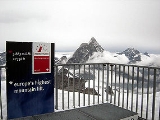
Klein Matterhorn
Encyclopedia
The Klein Matterhorn (marketed as the "Matterhorn Glacier Paradise") is the highest point in the Zermatt
-Cervinia
ski area in Switzerland, and the end point of the highest cable car
in Europe
. The peak is at 3883 metres (12,739.5 ft) with the cable car terminal at 3820 metres (12,533 ft).
and with the Swiss Nature Conservation Society. These discussions resulted in two large natural reserve zones (the "Matterhorn" region and the "Monte Rosa" region). The third area (the "Schwarzsee
-Theodul Glacier-Klein Matterhorn" region) was designated as a tourist zone.
Licensing was further delayed until 1969 by the citizens of Zermatt filing a complaint to governing council of the Canton of Valais. In December 1970, the Swiss government finally gave permission for the cable way, but progress was further delayed until 1973 by objections from environmentalists. Eventually, on 17 December 1973, the Federal Council rejected objections and granted a construction license.
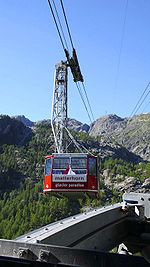 The next major obstacle proved to be the recruitment of a work force to build the lift system. At altitudes of 3000 to 4000m above sea level, worker productivity would be reduced by up to 50% compared to normal levels, and workers would be required to live for weeks on end within the camps.
The next major obstacle proved to be the recruitment of a work force to build the lift system. At altitudes of 3000 to 4000m above sea level, worker productivity would be reduced by up to 50% compared to normal levels, and workers would be required to live for weeks on end within the camps.
The construction of this cable car started in August 1976 at all three construction sites: the valley terminal, the three tower sites and the mountain terminal. Creation of the mountain terminal was a difficult undertaking. Some 2000 cubic metres of concrete were used in the mountain station, all of which had to be transported there by helicopter in specially insulated tanks, mixed with warm water and 2% anti-freeze. Weather conditions at the work site (3,820 metres above sea level) in high mountain terrain were extreme: temperatures falling to minus 40°C, snowfalls, and high winds of over 100 km/h.
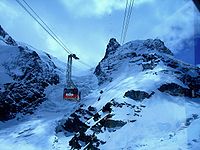
 In the summer of 1977 the track, hand and counter cables totalling 35.8 kilometres (22.2 mi) in length and weighing to 300 tonnes were dragged from Schweigmatten to Trockener Steg, a massive undertaking in itself. It took several weeks to cover the distance of 3,600 meters (11,808 feet), with a vertical altitude of almost 1,000 meters (3,280 feet) and to rewind the cables on their reels.
In the summer of 1977 the track, hand and counter cables totalling 35.8 kilometres (22.2 mi) in length and weighing to 300 tonnes were dragged from Schweigmatten to Trockener Steg, a massive undertaking in itself. It took several weeks to cover the distance of 3,600 meters (11,808 feet), with a vertical altitude of almost 1,000 meters (3,280 feet) and to rewind the cables on their reels.
On December 1978, all four track cables were installed, and all remaining operations were completed by the spring of 1979. In the fall of 1979, the two 100 passenger cabins were flown from the village of Täsch to the valley terminal, attached to the hanger frames with the carriages lifted on to the track cables, with operations finally starting on 23 December, the start of the winter season.
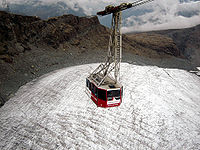
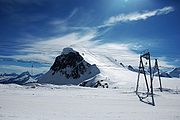 The Klein Matterhorn is at the end of a multi-stage cable car journey from Zermatt. As of 2005, over 14 million passengers had visited since completion, an average of 560,000 per year. The carriages were refurbished in 2005. There is also a panoramic view platform at 3,883 m, which can be reached by elevator—located midway through the tunnel—followed by a 10 m climb up stairs. The Ice Cave ("Glacier Grotto") is just outside the tram station with a view into the glacier below.
The Klein Matterhorn is at the end of a multi-stage cable car journey from Zermatt. As of 2005, over 14 million passengers had visited since completion, an average of 560,000 per year. The carriages were refurbished in 2005. There is also a panoramic view platform at 3,883 m, which can be reached by elevator—located midway through the tunnel—followed by a 10 m climb up stairs. The Ice Cave ("Glacier Grotto") is just outside the tram station with a view into the glacier below.
The station is a high-alpine environment, and in the thin air one must use caution when making any physical effort. If possible, take time to acclimatise on the way to the Klein Matterhorn. There are plenty of warnings about this on the way up.
The lift serves the largest and highest summer-ski area in Europe
. During summer months one can find many professional, as well as beginner, skiers here. Access to the ski slopes is via a tunnel blasted straight through the mountain.
It was announced in July 2006 the winning design for this construction was to consist of a pyramid of glass, with an observation platform at 4,000 meters with sky lifts on the outer wall to whisk passengers to the "new summit". http://www.zermatt.ch/data/pdf/zt/Winternews-200607-englisch.pdf Zermatt Mountain Cableways seem intent on marketing the construction as "the newest 4,000+ meter peak in the Alps".
Zermatt
Zermatt is a municipality in the district of Visp in the German-speaking section of the canton of Valais in Switzerland. It has a population of about 5,800 inhabitants....
-Cervinia
Cervinia
Breuil-Cervinia is an alpine resort in the Valle d'Aosta region of northwest Italy...
ski area in Switzerland, and the end point of the highest cable car
Aerial tramway
An aerial tramway , cable car , ropeway or aerial tram is a type of aerial lift which uses one or two stationary ropes for support while a third moving rope provides propulsion...
in Europe
Europe
Europe is, by convention, one of the world's seven continents. Comprising the westernmost peninsula of Eurasia, Europe is generally 'divided' from Asia to its east by the watershed divides of the Ural and Caucasus Mountains, the Ural River, the Caspian and Black Seas, and the waterways connecting...
. The peak is at 3883 metres (12,739.5 ft) with the cable car terminal at 3820 metres (12,533 ft).
Construction of the Klein Matterhorn cable car lift
Even before the construction license application was filed, the building promoter had to negotiate with the Swiss Alpine ClubSwiss Alpine Club
The Swiss Alpine Club is the largest mountaineering club in Switzerland. It was founded in 1863 in Olten and it is now composed of 111 sections with 110,000 members...
and with the Swiss Nature Conservation Society. These discussions resulted in two large natural reserve zones (the "Matterhorn" region and the "Monte Rosa" region). The third area (the "Schwarzsee
Schwarzsee (Zermatt)
Schwarzsee is a lake at Zermatt in the canton of Valais, Switzerland. It is located below Matterhorn at an elevation of 2,552 m....
-Theodul Glacier-Klein Matterhorn" region) was designated as a tourist zone.
Licensing was further delayed until 1969 by the citizens of Zermatt filing a complaint to governing council of the Canton of Valais. In December 1970, the Swiss government finally gave permission for the cable way, but progress was further delayed until 1973 by objections from environmentalists. Eventually, on 17 December 1973, the Federal Council rejected objections and granted a construction license.

The construction of this cable car started in August 1976 at all three construction sites: the valley terminal, the three tower sites and the mountain terminal. Creation of the mountain terminal was a difficult undertaking. Some 2000 cubic metres of concrete were used in the mountain station, all of which had to be transported there by helicopter in specially insulated tanks, mixed with warm water and 2% anti-freeze. Weather conditions at the work site (3,820 metres above sea level) in high mountain terrain were extreme: temperatures falling to minus 40°C, snowfalls, and high winds of over 100 km/h.


On December 1978, all four track cables were installed, and all remaining operations were completed by the spring of 1979. In the fall of 1979, the two 100 passenger cabins were flown from the village of Täsch to the valley terminal, attached to the hanger frames with the carriages lifted on to the track cables, with operations finally starting on 23 December, the start of the winter season.
Current operation


The station is a high-alpine environment, and in the thin air one must use caution when making any physical effort. If possible, take time to acclimatise on the way to the Klein Matterhorn. There are plenty of warnings about this on the way up.
The lift serves the largest and highest summer-ski area in Europe
Europe
Europe is, by convention, one of the world's seven continents. Comprising the westernmost peninsula of Eurasia, Europe is generally 'divided' from Asia to its east by the watershed divides of the Ural and Caucasus Mountains, the Ural River, the Caspian and Black Seas, and the waterways connecting...
. During summer months one can find many professional, as well as beginner, skiers here. Access to the ski slopes is via a tunnel blasted straight through the mountain.
Future plans
On December 9, 2005, the ZBAG (Zermatt Bergbahnen AG, the owner of this station) announced plans to significantly expand the facilities at the Klein Matterhorn. They had ordered studies from five large Swiss architectural firms stating some of the following demands: new heating-, water-, waste- and electricity-installations, new toilets, shop and cafeteria, restaurant, mountain cabin (40 beds, SAC (Schweizer Alpen-Club) style), new panoramic platform (new elevator), underground access to the gletscher palast (ice cave) and spare room for 2 cableways: one from Trockener Steg (3-cable gondola) and one from Testa Grigia (double cable car). Additionally: a private investor (Heinz Julen) launched the idea of a hotel. Official press announcement (in German) http://bergbahnen.zermatt.ch/d/medienmitteilung/2005/12/09.htmlIt was announced in July 2006 the winning design for this construction was to consist of a pyramid of glass, with an observation platform at 4,000 meters with sky lifts on the outer wall to whisk passengers to the "new summit". http://www.zermatt.ch/data/pdf/zt/Winternews-200607-englisch.pdf Zermatt Mountain Cableways seem intent on marketing the construction as "the newest 4,000+ meter peak in the Alps".

